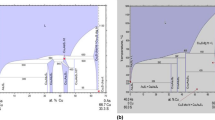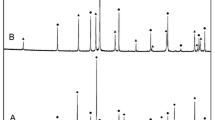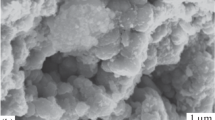Abstract
Thermodynamic properties were determined for the system cobalt oxide-copper oxide by means of an electromotive force (EMF) measurement techniques using galvanic cells with calciastabilized zirconia (CSZ) as the solid electrolyte and with air as the reference electrode according to the following schemes: CuO, Cu2O | CSZ | air and CoO-CuO, Cu2O CSZ | air for composition variables y=XCu/(XCo+Xcu equal to 0.05, 0.15, 0.25, 0.35, 0.45, 0.667, and 0.8; and within the temperature interval 1200–1350 K. Thermodynamic properties calculated directly from EMF values were combined with the available literature data on phase equilibria, and thermodynamic properties of solid phases in the Co-Cu-O system were assessed. Both terminal solid solutions, (Co,Cu)O and (Cu,Co)O, were described by a sublattice model with Redlich-Kister excess term. The interaction parameters for both (Co,Cu)O and (Cu,Co)O solid solutions and the Gibbs energy of formation for the intermediate phase Cu2CoO3 were obtained. The Gibbs energies of fictive end-members: monoclinic “CoO” and “CuO” with rock salt structure were derived as well. The phase diagrams were calculated using the assessed thermodynamic parameters. The (T, y) phase diagram was calculated for existence under ambient air. The property diagrams log10P(O2) versus composition and activity of CuO versus composition were calculated at 1273 K. The results of our calculations were in a good agreement with available experimental data.
Similar content being viewed by others
References
O. Redlich and A.T. Kister: “Algebraic Representation of Thermodynamic Properties and the Classification of Solutions,” Ind. Eng. Chem., 1948, 40, pp. 341–45.
F.C.M. Drissen, G.D. Rieck, and H.N. Coenen: “Phase Equilibria in the System Cobalt Oxide/Copper Oxide in Air,” J. Inorg. Nucl. Chem., 30, pp. 747–53.
C. Landolt and A. Muan: “Activity-Composition Relations in CuO-CoO Solid Solutions as Determined from Equilibria in the System Cu-Co-O,” J. Inorg. Nucl. Chem., 1969, 31, pp. 1319–26.
B. Jansson: “PARROT, User’s Guide,” TRITA-MAC 233, Royal Institute of Technology, Stockholm, Sweden, 1994.
B. Sundman, B. Jansson, and J.-O. Andersson: “The Thermo-Calc Databank System,” CALPHAD, 1985, 9, pp. 153–90.
Y.A. Chang and Hsieh Ker-Chang: Phase Diagrams of Ternary Copper-Oxygen-Metal Systems, ASM International, Materials Park, OH, 1989, pp. 39–48.
B. Sundman: “An Assessment of the Fe-O System,” J. Phase Equilibria, 1991, 12(1), pp. 127–40.
B. Hallstedt, D. Risold and L.J. Gauckler: “Thermodynamic Assesment of the Copper-Oxygen System,” J. Phase Equilibria, 1994, 15(5), pp. 483–99.
SGTE SUB94 Substance Database, Thermo-Calc, version L, Stockholm, Sweden.
N. Saunders and P. Miodownik: “CALPHAD (Calculation of Phase Diagram): A Comprehensive Guide” in Materials Series, 1, R.W. Cahn, ed., Pergamon, Oxford, United Kingdom, 1998.
J. Kubistal and J. Vrestal: “Thermodynamics of the Liquid Co-Cu System and Calculation of Phase Diagram,” J. Phase Equilibria, 2000, 21(2), pp. 125–29.
Author information
Authors and Affiliations
Rights and permissions
About this article
Cite this article
Zabdyr, L.A., Fabrichnaya, O.B. Phase equilibria in the cobalt oxide-copper oxide system. JPE 23, 149 (2002). https://doi.org/10.1361/1054971023604161
Received:
DOI: https://doi.org/10.1361/1054971023604161




